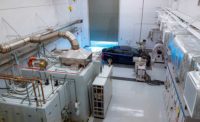Engineers are integrating thin, flexible electronics and sensors into belts, glasses, headgear, jewelry, shirts, shoes, watches and a wide variety of other products. Wearable electronics promise to radically alter everything from medical devices to sporting goods by providing an easy way to monitor the vital signs of patients, soldiers, athletes and other users.
The technology is expected to have an impact everywhere from the battlefield to the factory floor. Law enforcement applications alone are expected to skyrocket over the next decade, in the wake of recent high-profile police abuse incidents in Ferguson, MO, and New York City.
According to some recent studies, the wearable electronics market will become a $70 billion industry within 10 years. The University of California at San Diego is at the center of that revolution. In fact, UCSD’s Jacobs School of Engineering recently created the Center for Wearable Sensors.
“The goal of the organization is to increase collaboration between researchers and faculty, while supporting the local economy through the development of wearable sensors that monitor conditions in real-time,” says Joseph Wang, a nano engineering professor who serves as director of the center.
The Center for Wearable Sensors consists of more than 15 faculty members from multiple disciplines, such as bioengineering, computer science, electrical engineering and mechanical engineering, who are collaborating on various projects.
Wang and his colleagues are experimenting with wearable sensors embedded on clothes, temporary tattoos and patches, and implantable devices. They envision applications in which noninvasive sensors would be worn at all times to constantly monitor heart rate, blood glucose levels, muscle fatigue, stress rates and other health or performance values, such as saliva and sweat.
Advanced sensor technology being developed by UCSD engineers promise to transform electronics and textiles like they’ve revolutionized the auto industry.
“Twenty years ago, cars didn’t have sensors, and you wouldn’t know that it was broken until smoke came out,” argues Patrick Mercier, an assistant professor of electrical engineering and computer science who serves as associate director of the Center for Wearable Sensors. “Now, vehicles have more than 100 different sensors. Many alert for major issues before they actually happen. That’s the same concept as wearable sensors.”
“Power is one of the biggest challenges that’s we’re tackling,” adds Wang. “One of our goals is to make wearable devices as energy-efficient as possible.
“We want to make sensors so low-powered that they don’t need to be recharged,” explains Wang. “We are developing flexible batteries, in addition to looking into various ways to harvest energy, whether it’s through body heat, motion, sweat or radio waves.”
The UCSD engineers are also experimenting with a variety of flexible and stretchable materials that can withstand the mechanical stresses of the human body. “We are using advanced fabrics and plastics, such as polyimide,” says Wang. “Another challenge is how to process, store and secure all the data being generated.”
Several devices have already been developed, such as temporary tattoo-like sensors that analyze lactate levels to measure whether a person is experiencing muscle fatigue during a workout. Other items include minimally invasive microneedle sensors for monitoring chemical markers; wrist sensors for monitoring the vital signs of hospital patients; and mouthguards equipped with biosensors and biofuel cells that analyze saliva to determine a person’s stress level.
“We have also created on-body printable sensors, such as a forensic finger device that detects explosives and gunshot residues,” says Wang. “Another device embedded in wetsuits warns U.S. Navy divers when they are near explosives.
Wang and his colleagues are currently developing the world’s first “lab on the body,” which will feature continuous multiparameter sensing, wireless data transfer, cloud storage and real-time feedback. “These developments will provide comprehensive assessment of the wearer’s overall physiological status,” claims Wang.







